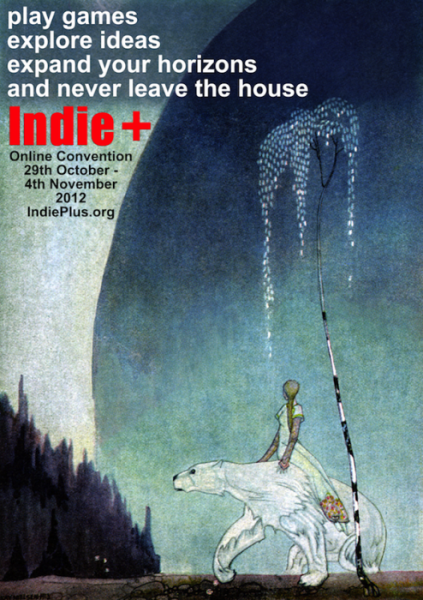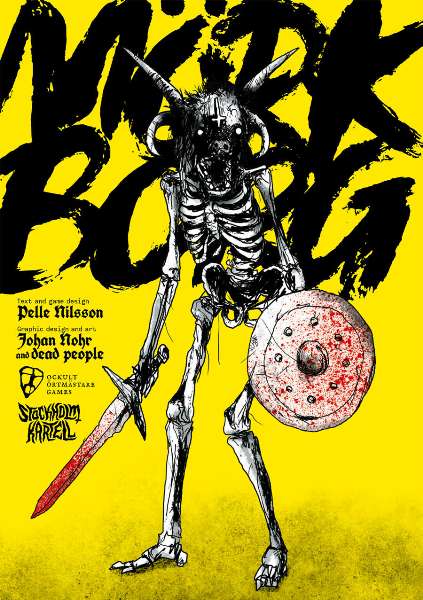Theme Mechanics
By The Warden
 If you’re a frequent reader of this series, it is my duty to inform you about Indie+, an online RPG convention going on through Google Hangouts. Many games mentioned in this column will be available for independent fans to try out, including the Matrix RPG, 6d6, and my own creation, Killshot. Dates are posted through the link above and there’s loads of room for more if you’re up for the challenge. (It’s the beauty of online cons; no limits based on space.)
If you’re a frequent reader of this series, it is my duty to inform you about Indie+, an online RPG convention going on through Google Hangouts. Many games mentioned in this column will be available for independent fans to try out, including the Matrix RPG, 6d6, and my own creation, Killshot. Dates are posted through the link above and there’s loads of room for more if you’re up for the challenge. (It’s the beauty of online cons; no limits based on space.)
And now, on with the show.
IT BEGINS WITH THE HILLFOLK
This past week, Robin Laws’ Hillfolk Kickstarter project launched and was (not surprisingly, really) funded within 24 hours. Currently the next big crowdfunding story, Hillfolk is built using the yet unpublished DramaSystem system and heavily influenced by Robin’s own popular book, Hamlet’s Hit Points. To quote the Kickstarter page…
“Hillfolk, the new game of Iron Age conflict from acclaimed designer Robin D. Laws, introduces to the roleplaying world his DramaSystem rules engine. You know those magical game sessions where the dice and rules fall away, and the entire group spontaneously enters a collective zone of pure story and character? DramaSystem’s basic structure reproduces that dynamic on demand.
DramaSystem’s key dynamic is based on the way character interplay occurs in fiction, movies, theater and television. It gives you the all the foundation you need to collectively weave rich, extended narratives. Then it gets out of your way.
You may recognize its driving insights from Robin’s Hamlet’s Hit Points. If that book is the theory, DramaSystem is the practice.”
– from the Hillfolk Kickstarter page
With perhaps one of the most profound careers in RPG design – particularly freelance RPG design – Robin Laws has proven himself an expert in theme games; those which focus on a particular aspect normally overlooked in some of the most popular RPGs. He’s the same man behind GUMSHOE and Feng Shui, two of the best genre systems on the market from my point of view. His specialty lies in converting aspects commonly left as advice columns in most RPGs and building an entire system around them so that the game reflects it as a core value. With GUMSHOE, for example, players can use their characters to decipher clues and solve mysteries from the back of their van without relying on the precious dice rolls nearly every other game requires.
THEME MECHANICS
When I use the term “theme games,” there’s a bit of a misnomer in its use. Truthfully, all roleplaying games are theme games despite the intention of a RPG as a vehicle for allowing players to do whatever they want. Anyone who was ever a child knows that without some form of boundary keeping everyone on the same page, a game of hide and seek can quickly turn into a shouting match because little Jimmy decided the game needed a marshmallow cannon. Twisting that analogy to suit our purpose here today, the majority of RPGs available serve as a generic “hide and seek”; theme games say, “what about a game where you play hide and seek with a marshmallow cannon?” When successful, you leave players wondering why they never thought of bringing sugary weapons to the playground before.
Holding these games together are what I like to call theme mechanics. While every system handles certain key universal aspects, such as combat, theme mechanics start with a foundation aiming to highlight one aspect and make it the dominant feature. With GUMSHOE, for example, the system is built around investigation and information as its primary goal and creates a game capable of allowing players to avoid dice rolls for all their information (essentially the reward of the players’ roleplaying and detective work). Rarely built for a universal audience, they tap into the needs of specific player types and give them what they’re craving from other games.
Unlike theme games built with unique mechanics, these are open systems intended for use with various settings and subject matter. The GUMSHOE system erected settings as varied as the Esoterrorists (an investigation RPG), Ashen Stars (an elaborate science fantasy RPG), and the brand new Night’s Black Agents (paranormal exploits and conspiracy theories). Each setting may revise a few details and expand on the rules through individual add-ons, but the core mechanic remains.
Doing so tends to mean an otherwise universal aspect of most systems will be diminished or at least toned down compared to others. Personally, I find GUMSHOE to be incredibly weak in combat (which is why I was thrilled to learn about Lorefinder, a GUMSHOE-Pathfinder hybrid) and as a combat enthusiast, it wasn’t to my style. But I was still very impressed with the investigation resolution; they nailed down the process far better than any others I’ve experienced.
Other examples of theme mechanics are from the Cortex and Cortex+ systems, with games such as Supernatural, Smallville, and Marvel Heroic Roleplaying. Each game uses these systems to emphasize the individual behind the actions and the relationships between them while keeping up with the need for elaborate and fantastic combat. When you’re dealing with super-powered humans and aliens fighting galactic villains, it is the ultimate in combat – you can get into a fistfight in midair or smash through a brick wall as soon as you start playing, not after playing for ten levels. By incorporating a character’s history and personality to gain experience and choosing dice by the hero’s morals and camaraderie, the Marvel RPG proved it could create a vivid tribute to comic books with their award for Best Rules in this year’s ENnies.
Some theme mechanics place effort on complimenting the overall style of a setting, as it was with the Storyteller system in the original World of Darkness games (Vampire, Wraith). Its mechanics were not exclusively designed to spark players to embrace the roleplaying aspect of the genre, but they sure as hell did encourage it. The setting itself could be hacked from other systems and still invoke Gothic intrigue and horror (such as when Monte Cook created his own version of the World of Darkness, published by White Wolf).
PART OF THE EVOLUTION
On their own, they serve a mighty purpose. The unexpected benefit has been the eye-opening experience hacked into hybrid systems and house rules across the community. Everyone’s borrowed something from theme games to fill voids interpretively left behind by other universal systems (I can recall loads of these merges seeking to improve or replace D&D 4th edition’s skill challenges).
This is what theme mechanics bring to the table (literally and figuratively): they teach us the value of overlooked aspects and provide incentive for future games and editions to incorporate them into the next generation. It’s the evolution of roleplaying games. Every step up, addition, variant, and theme opens our eyes to the genre’s potential and inspires up-and-coming and experienced designers alike to try out a piece.
Perhaps the greatest evidence of this impact is live action roleplaying games (LARPs). While it has likely existed in some form or another for decades before – even dating back to the classic murder mystery party game – the popularity of the World of Darkness setting and its effect on its sub-culture lead to the publication of the Mind’s Eye Theatre line from White Wolf.
Yet again, it leaves us wondering the possibilities in the next generation of gaming. Thanks to crowdfunding, projects otherwise considered risky or uncertain by a publisher have an opportunity to impress a wider public. If the idea of character driven RPGs takes hold now, what will become of latter editions of D&D, GURPS, and other major RPGs? Once again, only time will tell.

